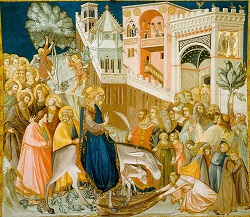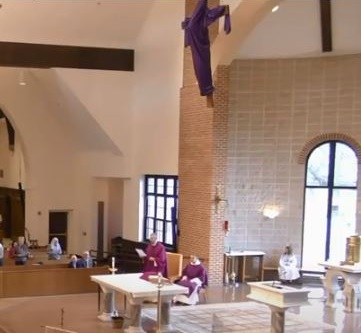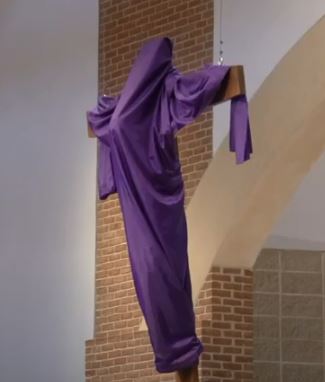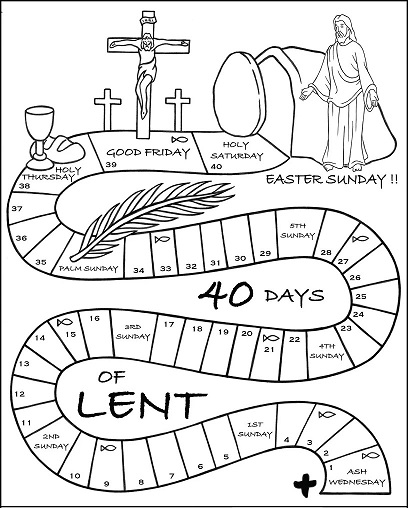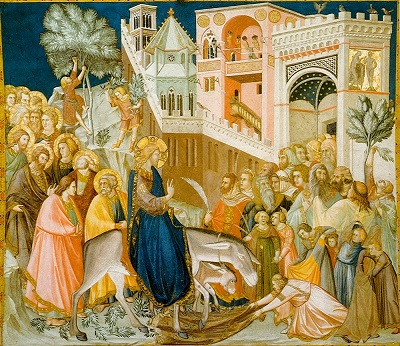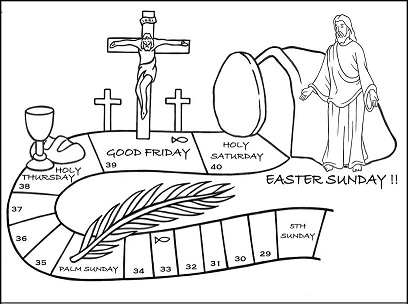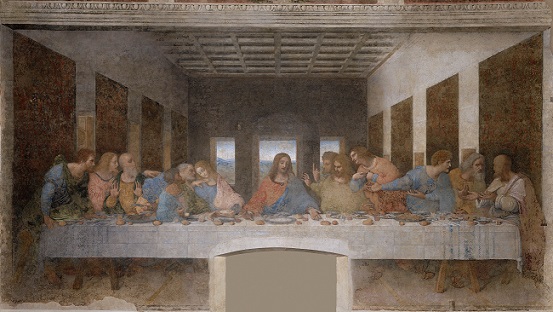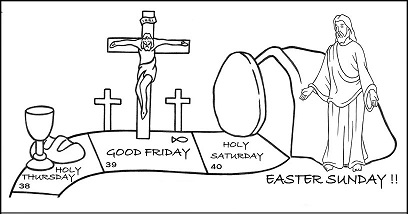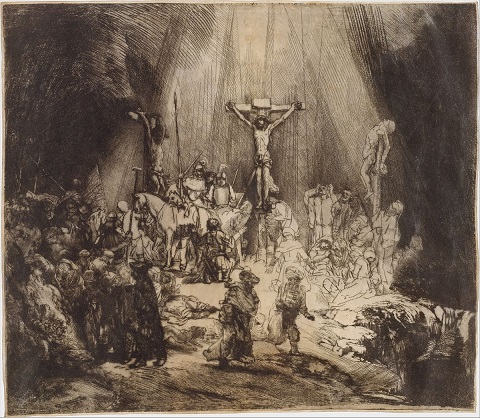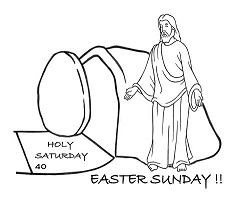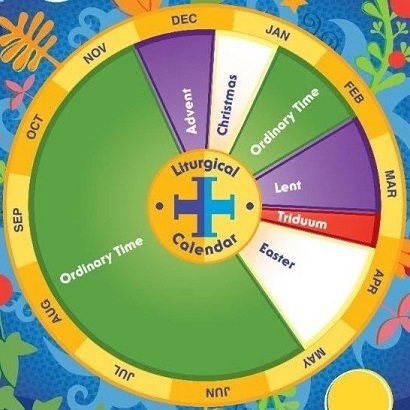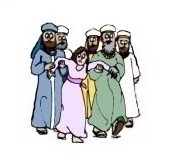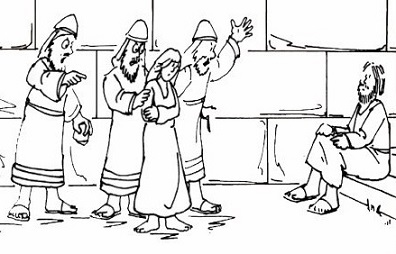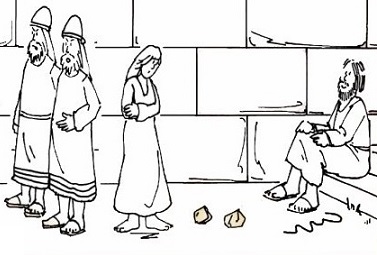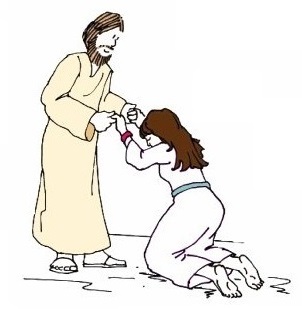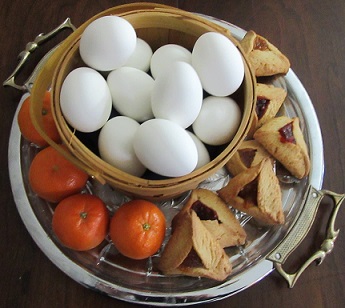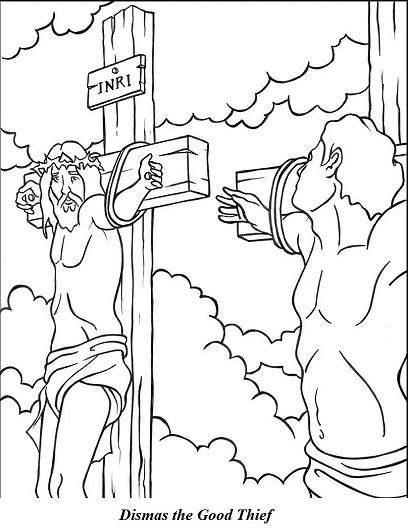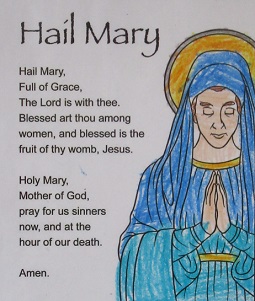Let’s begin with the Sign of the Cross:
Liturgical
Calendar: You may have seen something unusual at Mass this weekend at de Chantal: The big crucifix that hangs above the altar was covered with purple cloth. Did you see that? Here’s a picture:
The season of Lent began on Ash Wednesday. That was five weeks ago. The Sunday that happened two days ago was the 5th Sunday of Lent. This coming Sunday will be Palm Sunday. And the Sunday after that will be Easter Sunday. We are very close to Easter. The purple covering over the crucifix reminds us how very close we are to Easter. The covering reminds us that we REALLY need to be getting ready for Easter. For Catholics who have made their 1st Communion, getting ready for Easter means that it’s time to make sure that we’ve had the Sacrament of Reconciliation, so that we may take Communion on Easter Sunday. That’s because taking Communion on Easter Sunday is more important than chocolate Easter bunnies. Let’s look at this roadmap to Easter: Lent begins on Ash Wednesday. That was the day when we went to church and had our foreheads marked with ashes, in a Cross. Lent lasts for 40 days — NOT counting Sundays. You can count out those days on the map. Today [April 5th], we’re at the day 30, two days after the 5th Sunday of Lent. You see that this coming Sunday will be Palm Sunday. That will be the day when we remember when Jesus came into the city of Jerusalem, with people praising him all the way. The people loved Jesus so much that crowds gathered on the roads as he came into Jerusalem. Jesus was coming to Jerusalem because it was the time of Passover, a Jewish holiday. Remember: Jesus was a Jewish man, and Jesus followed Jewish holidays. Many artists have made paintings about that day. Here is one: This painting shows Jesus riding on a donkey, with people having put palm branches on the ground for him to ride over. One man has put his cloak on the ground, so that Jesus' donkey did not have to walk on dirt. Everyone loved Jesus on that day. And, at church on Palm Sunday, we will be given Palm leaves, to remember that day when Jesus came into Jerusalem and people praised him and waved palm leaves. Let's look at the roadmap again:
After Palm Sunday is day 35, then day 36, then day 37. On Day 38, you see a chalice — a cup — and the words “Holy Thursday.” Just a few days after Jesus arrived in Jerusalem, with people welcoming him by waving palm branches, Jesus gathered with his disciples, the 12 Apostles, for a Passover meal. (The Passover meal is what Jewish people call the “seder.”) That meal was the last meal that Jesus had with his 12 Apostles. That was the Last Supper. And there is LOTS of art about the Last Supper. This is perhaps the most famous. The artist is Leonardo da Vinci: This painting is a fresco. That means that da Vinci painted it on a wall. Over the centuries, some of the paint has flaked off and faded. When Jesus was with the Apostles on that day, the day of their last supper, Jesus took bread, broke it, and offered it to his disciples. He said, "Take this bread, and eat it. This is my body." Before they ate, Jesus washed the feet of the Apostles. Jesus showed them that He loved them and that He would serve them.
If you come to church on that evening, you will see the priests washing the feet of some parishioners. It is done in memory of what Jesus did. Sometimes we call Holy Thursday “Maundy Thursday.” And some people call it “foot-washing Thursday.” The next day on the map is # 39, Good Friday. There is a drawing of Jesus nailed to a cross, and there are two other crosses. There were two other men who were crucified on the same day when Jesus was crucified. We know them only as “the good thief” and “the bad thief." This art depicts Christ Crucified between the Two Thieves. The artist is Rembrandt: The artist cut a picture into a sheet of copper, a kind of metal. Then, the artist spread ink onto the sheet of copper and printed the picture. The picture shows Jesus hanging on a cross. On each side of Jesus, there is a man hung on a cross. There were three crosses that day. Near Jesus, there are men on horses. Those men were Roman soldiers. There are many people watching. We are told that Jesus' mother was there, praying and seeing what was happening to her son. Jesus hung on the cross for three hours before his body gave out. We remember those three hours on Good Friday, from noon to 3 p.m. That is day # 39 of Lent.
Day 40 is Holy Saturday, when Jesus’ body was in a tomb, in a cave, behind a giant-sized rock. And the next day is Easter Sunday, when Jesus rose from the dead. On Easter Sunday, people who went to visit the tomb found that the tomb was empty. Come to church on Easter Sunday, and Father Giese will explain that. There is a very short season in the Catholic calendar that is called the “Triduum.” The season’s color is red. Look at this liturgical calendar. It shows the Church year, which repeats every year, year after year:
Right now, we are in the season of Lent. It is one of the two purple colors. Think of the circle calendar as a clock: The last season we were in was Ordinary Time (green). Now we are in Lent (purple). The next season will be the season of the Triduum (red). The Triduum begins on the evening of Holy Thursday, and it ends on the evening of Easter Sunday. NOTE TO PARENTS: My
apologies for not correctly pronouncing the word
"Triduum" in class. The correct pronounciation
can be heard here: GOSPEL:
ASK: What do you think about what happened? What do you think about what Jesus did? How do you feel about the story? SNACK: Remember
how to say grace before meals? TEXTBOOK:
EGG COLORING CLOSING PRAYERS: Time to say goodbye. :-) We'll begin with the Our Father. Remember that our next class will be on April 26. For two weeks, there will be no class. During that time, there will be Palm Sunday, Holy Thursday, Good Friday, and Easter Sunday. When we next see each other, we will be in the Easter Season.
|
